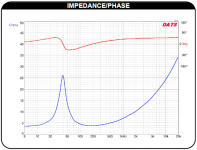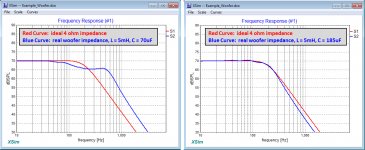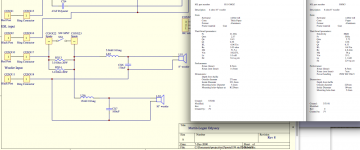Hi Guys,
Need advice. I recalled that the Odyssey low pass xo is set at 270hz.
when I calculated the 2nd order using butterworth the inductor value of
5mh is correct but the cap value should be 70uf. Question, why is ML using
170uf instead. Would appreciate some explanation here
Thks
View attachment ML Crossover.pdf
Need advice. I recalled that the Odyssey low pass xo is set at 270hz.
when I calculated the 2nd order using butterworth the inductor value of
5mh is correct but the cap value should be 70uf. Question, why is ML using
170uf instead. Would appreciate some explanation here
Thks
View attachment ML Crossover.pdf
Remember that the impedance of the woofer will not be a constant 4ohm resistance. It has inductance as well. Attached is an example woofer impedance curve showing the rising impedance at higher frequencies caused by the inductance.
To compensate for non-constant impedance the values of crossover parts, like the capacitor, need to be adjusted to achieve the desired low pass crossover response. It is difficult to do properly without measurement equipment.
To compensate for non-constant impedance the values of crossover parts, like the capacitor, need to be adjusted to achieve the desired low pass crossover response. It is difficult to do properly without measurement equipment.
Attachments
At those sizes, aren't those electrolytic caps? Must be something of a conjecture to assess their capacitance in operation. And the capacitance must shift around with various long- and short-term factors. Data?
I've come to think that these passive crossovers* are inconceivably shoddy element in a quality system. Silly putting such a gizmo between the amp and (most kinds of) speaker. Just can't be done by-the-book. That's what quality manufacturers spend many testing hours and end up with 18-element crossovers to make 'em work right.
B.
*I can never remember which is called high-level and which is low-level
I've come to think that these passive crossovers* are inconceivably shoddy element in a quality system. Silly putting such a gizmo between the amp and (most kinds of) speaker. Just can't be done by-the-book. That's what quality manufacturers spend many testing hours and end up with 18-element crossovers to make 'em work right.
B.
*I can never remember which is called high-level and which is low-level
Last edited:
I've played with the front woofer crossover by changing cap value as well
1st order just using the coil & a couple of resistors to lower output.
I get a clearer sound & open sound. I kind of wonder besides taming the
impedance, was ML trying also to merge sound of woofer & panel more
consistantly. From experience speakers with low mounted woofer don't
sound gd or intergrated in Asia whereby houses are mostly brick, cement,
concrete construction. In order to resolve this I raise the speakers at least
5 inches above the floor. Bass expands & does not sound like looking down
on the bass at floor level.
Cheers
1st order just using the coil & a couple of resistors to lower output.
I get a clearer sound & open sound. I kind of wonder besides taming the
impedance, was ML trying also to merge sound of woofer & panel more
consistantly. From experience speakers with low mounted woofer don't
sound gd or intergrated in Asia whereby houses are mostly brick, cement,
concrete construction. In order to resolve this I raise the speakers at least
5 inches above the floor. Bass expands & does not sound like looking down
on the bass at floor level.
Cheers
Yes, changing the capacitor value will change the crossover, but that is what is required to achieve the desired crossover response when the real woofer impedance is used instead of an ideal 4 ohm resistor. Attached below is an example to illustrate the difference in response when crossover parts are driving an ideal resistive load vs. driving a real woofer that has inductance. I don't have the impedance curve for the Odyssey woofer, so I just used an 8" woofer I had on file. In this case a capacitor value of 185uF provided the best fit to the desired crossover response.… Wouldn't increasing the value of the capacitor from 70 - 170 uf changes the crossover frequency as well ?
- The red curve shows the desired crossover response for the woofer.
- The blue curve in the left plot shows that when the component values for an ideal 4 ohm crossover are used with a real woofer, the crossover doesn’t roll off until well above the desired frequency.
- The blue curve in the right plot shows that if the capacitor value is adjusted upwards you can achieve very close to the desired response even when used with a real woofer.
Every woofer and crossover frequency will require unique adjustments to achieve desired response. Without measurement equipment, it is difficult if not impossible to do.
Attachments
Last edited:
Here's what we're looking at in one place, attached.
Ordinarily it would be easy to suggest using active xo on the bass, but on Odyssey there are two different bass drivers doing slightly different things (in separate sealed compartments), so one would need 1 channel of xo & amp per woofer, which could get a bit involved.
All that in parallel is a miserable load for any amp. Try passive bi-amping? Whatever you do, don't use the bass cut control.
Ordinarily it would be easy to suggest using active xo on the bass, but on Odyssey there are two different bass drivers doing slightly different things (in separate sealed compartments), so one would need 1 channel of xo & amp per woofer, which could get a bit involved.
All that in parallel is a miserable load for any amp. Try passive bi-amping? Whatever you do, don't use the bass cut control.
Attachments
This is often the case. The design of the speaker will be optimized to give the best response for most listening rooms. This doesn't necessarily mean it will in yours, especially at the lower frequencies where the room has the biggest effect on the sound. If you can measure the sound at your listening position, you will better understand why it isn't sounding as good as you would like. Then perhaps we could figure out how best to correct the problem.Though it may measure ideally but in my listening
room it does not sound so good
And often forgotten is that there is a disconnect between physical sound measurements and human preferences. The concept of "house curve" (your personally preferred freq response OR the industry standard "preference" such as for movie theatres) captures my meaning as far as freq response goes. But there are other qualities such as ambiance, etc. where there are limitations to how far physical measurements can lead you.
For sure, physical measurements are essential and beneficial in a million ways. Just saying the development struggle doesn't end there.
(We're all hoping much respected posters in Fort Worth and elsewhere in Texas aren't getting flooded.)
B.
For sure, physical measurements are essential and beneficial in a million ways. Just saying the development struggle doesn't end there.
(We're all hoping much respected posters in Fort Worth and elsewhere in Texas aren't getting flooded.)
B.
Last edited:
Thank you kindly again Bolserst. Unfortunately I dont have
any measuring equipment. For now I've gone back to the original
Xo values but have added a 0.01uf cap across. This opens up the
sound without calling attention to itself . Before it sounded muffled
& on certain music it draws your attention towards the front
firing woofer.
Thanks again
any measuring equipment. For now I've gone back to the original
Xo values but have added a 0.01uf cap across. This opens up the
sound without calling attention to itself . Before it sounded muffled
& on certain music it draws your attention towards the front
firing woofer.
Thanks again
- Status
- This old topic is closed. If you want to reopen this topic, contact a moderator using the "Report Post" button.
- Home
- Loudspeakers
- Planars & Exotics
- ML Odyssey low pass XO Q pls


